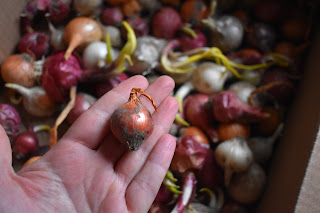In the old days, a man’s riches were not found in his bank,
but in his food bank, which was measured by the amount and diversity of his
seeds.
Before there were supermarkets and cheap transportation, the
food security of a family depended on their ability to grow and raise food of
their own. Their seeds needed to be carefully saved and protected so they would
have food to grow the next year.
 |
| Seed storage house at Mt. Vernon |
In the book,
Animal,
Vegetable, Miracle, Barbara Kingsolver writes, “According to Indian crop
ecologist Vandana Shiva, humans have eaten some 80,000 plant species in our history.
After recent precipitous changes, three quarters of all human food now come
from just eight species, with the field quickly narrowing down to genetically modified
corn, soy, and canola.”
We are massively losing the diversity of our food system,
and seed banks aim to preserve that diversity.
Seed banks preserve our heirloom and open pollinated seeds.
Open pollinated seeds allow the plants to breed true to their parentage, which
allows growers to save the seeds and replant them every year.
This cannot be done with hybrid and GMO seeds, which are
bred for one-time-use for one growing season.
One benefit of seed banks is that they allow growers freedom
within the food system. When growers have access to these heirloom varieties,
they can grow and save these seeds for the rest of their lives and pass them
down to future generations.
Many hybrid and GMO seeds are bred for traits that make them
grow faster, produce more, and ship well. Heirlooms are known for their incredible
flavors and are more nutrient dense.
I was so excited that my family had a chance to visit the
seed bank at The Farm at Prophetstown. They started their heirloom seed bank a
year ago and received a grant to purchase heirloom seeds to add to their seed
bank. This past weekend they opened up the seed bank for anyone to come and
choose from a huge variety of seeds, and take sample packets home to grow
themselves.
I knew I’d be drawn in before we got there because I love
learning about different seed varieties, but I was delighted to see my girls
were absorbed too, fingering through the seed packets, reading the descriptions,
and looking for something that interested them to grow for 4-h this year.
The Prophetstown staff was warm and welcoming. They made us
feel like family and encouraged us to take seeds, only asking that we
would share some of seeds with the seed bank the following year.
The setup was well organized and beautiful. As people came
in and asked questions, the staff was incredibly knowledgeable. Several people
shared stories of their own gardening experiences and even brought in seeds
they’d grown and saved from Prophetstown from the year before.
I ordered all the seeds we needed for market back in January
(the free sample packets provided from Prophetstown are not to be used for
monetary gain), but I always grow a test plot of new heirlooms every year. I do
this because I love vegetables and for the adventure of trying something new,
but also to save seeds for our own mini seed bank, to preserve the history and stories
of these old varieties, and to participate in the freedom of our food system.
 |
| I grabbed a few black beans to grow in my 2020 test plot |
I encourage you to seek out a seed bank near you, participate
in a seed exchange, or buy a packet of heirloom seeds.
Plant them. Grow them. Eat them. Save them. Share them. By
doing this you will preserve the integrity, history, and diversity of our food system.
*special thanks to the staff at Prophetstown, who were so kind to let me come in early and take some pictures!



















